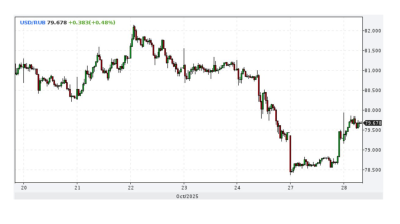In the last few days, Russia has seen the number of new cases of coronavirus (COVID-19) reported accelerate sharply.
As of April 21, Russia had reported a total of 52,763 cases of the deadly virus, with numbers growing by around 5,000 a day over the last three days, according to World Health Organisation (WHO) data.
On April 19 Russia reported 6,060 new cases, considerably less than the US, which has been reporting tens of thousands every day, but ahead of any other nation worldwide, including other European countries with major outbreaks such as Italy, Spain, Turkey and the UK.

Russia has seen some of the fastest growth in new coronavirus cases outside the US. Source: WHO
The tally reported for April 20 was zero, as presumably Russia did not report new cases from the previous day, which was Orthodox Easter Sunday. However, on April 21, the WHO reported a jump of 9,910 new cases.

Russia lags behind only the US and UK in terms of the number of new cases in the last week. Source: WHO
Russia was one of the later countries in the Central and Eastern Europe region to announce a lockdown, with restrictive measures initially imposed in the capital Moscow at the end of March.
The Russian government is likely to prolong the lockdown measures at least until the end of the May holidays, beginning with May 1 to May 5, and ending with the Victory Day holidays from May 9 to May 11, RBC business daily reported on April 20 citing unnamed official sources.
The days in between, from May 6 to May 8, will be announced as non-working. The lockdown has already been prolonged by President Vladimir Putin until end-April.
Other sources suggest that the lockdown will be extended at least to mid-May, and possibly to June 1.
As reported by bne IntelliNews, the base-case recession scenarios for Russia count about two months of lockdown in April-May, and its extension beyond that would be seen as strongly negative. Consensus expectations are moving into range of a 3-5% GDP contraction in 2020.

Turkey is also seeing continued strong growth in the number of new cases, at over 4,000 a day according to officially reported figures. The number of cases in Turkey reached 90,980 on April 21, putting it ahead of Iran, previously the country with the Eurasia region’s biggest outbreak.
The New York Times suggested on April 20 that the “Istanbul death toll hints Turkey is hiding a wider coronavirus calamity”. Compared to recent years, Istanbul recorded 2,100 more deaths than expected between March and April, the newspaper found, suggesting a hidden toll.
Elsewhere in Central and Eastern Europe, the largest outbreaks are in Poland and Romania, with total infection counts of 9,593 and 8.936 respectively, according to WHO figures released on April 21.
The spread of the virus is starting to tail off in several CEE countries, with new cases now numbered in tens rather than hundreds, and dropping to single figures in some cases. On April 21 there were under 10 new cases in Georgia, Montenegro and Slovenia.
In response, some governments have announced partial lifting of their lockdowns, while others are looking at the best ways to enable their economies to restart without prompting a new wave of infections.
However, other countries in the eastern part of the region are seeing numbers increase by several hundred a day, among them Belarus, Ukraine, Serbia and Poland.
Further east, the figures in Central Asia and the Caucasus are broadly in line with those of Central and Southeast Europe. The outliers are Mongolia, which to date has reported only 31 cases, all imported, and Tajikistan and Turkmenistan, where the authorities claim there are no cases at all.
Like Russia, where few cases were reported early on but a lot of people were in Moscow hospitals with pneumonia, the Tajik authorities have reported a spike in pneumonia cases, while the recent death of prosecutor Jaloliddin Abdujabborzoda was attributed to swine flu.
Many of the Tajik migrant workers whose remittances account for a significant amount of Tajikistan’s cash inflows have returned home over the past few months due to coronavirus-driven recessions in the countries where they normally work, the Tajik economy ministry said on April 17. The vast majority of Tajiks working abroad, numbering in the hundreds of thousands, had worked in Russia.
Data

Ruble strengthens as sanctioned oil companies repatriate cash
The Russian ruble strengthened after the Trump administration imposed oil sanctions on Russia’s leading oil companies, extending a rally that began after the Biden administration imposed oil sanctions on Russia in January.

Russia's central bank cuts rates by 50bp to 16.5%
The Central Bank of Russia (CBR) cut rates by 50bp on October 24 to 16.5% in an effort to boost flagging growth despite fears of a revival of inflationary pressure due to an upcoming two percentage point hike in the planned VAT rates.

Ukraine's trade deficit doubles to $42bn putting new pressure on an already strained economy
Ukraine’s trade deficit has doubled to $42bn as exports fall and imports balloon. The balance of payments deficit is starting to turn into a serious problem that could undermine the country’s macroeconomic stability.

BYD surpasses Tesla to become EV market leader – Statista
While Chinese manufacturer BYD already pulled ahead of Tesla in production volume last year, with 1,777,965 battery electric vehicles (BEV) produced in 2024 (4,500 more than Tesla), the American manufacturer remained ahead in sales.




